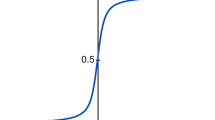Abstract
Family networks have increased at an accelerated pace through social networking through social networking services, online platforms, and social media clubs. This paper develops a model of an economy populated by networks of families with similar preferences (the same functional form of the felicity or utility function) but family members differ in their deep parameters (compulsion for consumption and risk tolerance), which, in turn, leads to some kind o heterogeneity among the families. In this context, the problem of felicity (utility) maximization of the average family in the network is solved. The optimal path of consumption is obtained for the average family and graphical comparative static exercises are performed. Finally, the economic welfare of the typical family in a network is calculated and comparative static experiments are carried out. This approach improves the understanding of the consumption decision making of families interacting in social networking services.

Source: Own elaboration

Source: Own elaboration
Similar content being viewed by others
Notes
References
Cremer, H., Gahuari, F., & Ladoux, N. (2003). Environmental taxes with heterogeneous consumers: An application to energy consumption in France. Journal of Public Economics, 87(12), 2791–2815.
Dhami, S., & Al-Nowaihi, A. (2010). Redistributive policies with heterogeneous social preferences of voters. European Economic Review, 54(6), 743–759.
Drugeon, J. P. (2010). On sectoral supply functions and some critical roles for the consumptions and leisure arbitrages in the stability properties of a competitive equilibrium with heterogeneous goods. Journal of Mathematical Economics, 46(6), 1030–1063.
García-Guerrero, V. M., & Venegas-Martínez, F. (2005). Control óptimo determinista aplicado al problema económico de crecimiento endógeno. Revista Ingeniería, Investigación y Tecnología, 6(2), 127–137.
Growiec, K., Growiec, J., & Kamiński, B. (2018). Social network structure and the trade-off between social utility and economic performance. Social Networks, 55, 31–46.
Keim, S. (2011). Social networks and family formation processes: Young adults’ decision making about parenthood. Heidelberg: Springer Fachmedien Wiesbaden, Springer.
Magnani, R., & Mercenier, J. (2009). On linking microsimulation and computable general equilibrium models using exact aggregation of heterogeneous discrete-choice making agents. Economic Modelling, 26(3), 560–570.
Nawrocki, D., & Viole, F. (2014). Behavioral finance in financial market theory, utility theory, portfolio theory and the necessary statistics: A review. Journal of Behavioral and Experimental Finance, 2(1), 10–17.
Norbutas, L., & Corten, R. (2018). Network structure and economic prosperity in municipalities: A large-scale test of social capital theory using social media data. Social Networks, 55, 120–134.
Oliveri, M. E., & Reiss, D. (1987). Social networks of family members: Distinctive roles of mothers and fathers. Sex Roles, 17(11–12), 719–736.
Palafox-Roca, A. O., & Venegas-Martínez, F. (2013). Consumption decisions in an economy with heterogeneous preferences defined by a bivariate distribution. Economic Bulletin, 33(2), 993–1000.
Palafox-Roca, A. O., & Venegas-Martínez, F. (2014). Average consumer decisions in an economy with heterogeneous subjective discount rates and risk aversion coefficients: The finite horizon case. Economic Bulletin, 34(2), 842–849.
Perrotini-Hernández, I., & Venegas-Martínez, F. (2011). Crecimiento endógeno con bienes heterogéneos: Un modelo de crecimiento no balanceado en los diferentes sectores de la economía. Panorama Económico, 6(12), 5–22.
Rindfuss, R. R., Bumpass, L. L., Choe, M. K., & Tsuya, N. O. (2004). Social networks and family change in Japan. American Sociological Review, 69(6), 838–861.
Roche, H. (2011). Asset prices in an exchange economy when agents have heterogeneous homothetic recursive preferences and no risk free bond is available. Journal of Economic Dynamic and Control, 35(1), 80–96.
Pollak, A. (2007). Optimal unemployment insurance with heterogeneous agents. European Economic Review, 51(8), 2029–2053.
Venegas-Martínez, F. (2008). Riesgos financieros y económicos. Productos derivados y decisiones económicas bajo incertidumbre (Segunda ed.). México: Cengage Learning.
Venegas-Martínez, F. (2000). Utilidad, aprendizaje y estabilización. Gaceta de Economía, 5(10), 153–169.
Venegas-Martínez, F. (1999). Crecimiento endógeno, dinero, impuestos y deuda externa. Investigación Económica, 59(22), 15–36.
Winters, P., de Janvry, A., & Sadoulet, E. (2001). Family and community networks in Mexico-US migration. Journal of Human Resources, 36(1), 159–184.
Author information
Authors and Affiliations
Corresponding author
Additional information
Publisher's Note
Springer Nature remains neutral with regard to jurisdictional claims in published maps and institutional affiliations.
The authors appreciate and thank the two anonymous referees for all their valuable comments and suggestions.
Appendices
Appendix A
Let \( k_{t} = k_{H\,t} + k_{M\,t} , \) so, then, the allocation of resources is obtained by solving the equation:
which solution is given by (integration by parts)
Appendix B
The optimal consumption paths are given by
Therefore,
which is substituted into
to obtain
which readily provides Eq. (8).
Rights and permissions
About this article
Cite this article
Palafox-Roca, A.O., Rodríguez-Aguilar, R., Castillo-Ramírez, C.E. et al. Optimal consumption decisions of family networks with similar felicity functions. Wireless Netw 26, 5703–5712 (2020). https://doi.org/10.1007/s11276-019-02063-x
Published:
Issue Date:
DOI: https://doi.org/10.1007/s11276-019-02063-x




